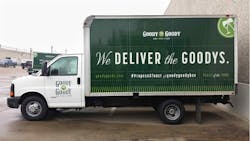Company: Goody Goody Liquors, Dallas, TX
Operation: Private fleet distributing wholesale alcohol products to bars and restaurants from four warehouses
Problem:
Planning routes and schedules for 25 trucks servicing nearly 2,000 customers is a complex job. When those customers are in the business of serving food and drinks, the job becomes even more complex with narrow delivery windows since businesses can’t accept deliveries during peak business times at lunch, dinner or cocktail hours. Then add in Texas liquor laws that prohibit wholesale alcohol sales across county lines, making route perimeters inflexible.
A classic American business success story, the company was started in 1964 as a single retail store. The name Goody Goody was chosen because it saved founder Joe Jansen $600, as the store was originally called Goo Goo and all he had to do was add “dy” to the sign.
Within two years, it moved into the wholesale business and after some bumpy growth pains, gradually grew into its current operations, which also includes a chain of retail outlets.
Such organic growth meant the company simply added trucks and routes as its customer base grew. Routes were created by the warehouse managers and presented to drivers as handwritten instructions. While that might work for a smaller operation, Goody Goody had outgrown such seat-of-the-pants distribution operations.
Solution:
Given all the variables faced on a daily basis by Goody Goody’s wholesale distribution fleet, the obvious answer was some type of transportation planning software. “[What we were doing] wasn’t efficient. We were running unnecessary miles and either missing some stops or arriving later than we should,” says Chris Otey, transportation manager. For a company that credits its success to flawless customer service, that was a real problem.
“We needed to automate, so in late 2012 we installed Paragon Software’s single depot system in one of our four main warehouses,” says Otey.
With Paragon handling the initial implementation, the main expectations for the system were to minimize unnecessary route miles and to reliably meet customer delivery windows. Quickly evaluating that first installation a success, Paragon installed its routing system in two other Goody Goody warehouses, and with that experience under his belt, Otey took installation in the fourth at the end of 2013.
Between the four warehouses, the automated routing system has cut about 100 mi. a day, which translates into one less truck for both morning and evening delivery shifts, Otey estimates.
“It also means we can handle more customers per trip, so we’ve been able to rationalize capacity and shift some trucks between warehouses instead of adding equipment.” Not to mention resulting in fuel savings as well.
The software creates a database of customer delivery requirements, fleet size and capabilities, delivery windows, driver work schedules, and other parameters a user like Goody Goody deems important. Using input from the fleet to help manipulate that data, it then creates practical routes and schedules that optimize truck productivity and minimize overall transportation costs.
Building on that initial automated routing function, the fleet has now begun feeding the Paragon system with GPS data from Navman Qube units carried by each truck.
“When the driver is making a delivery, we can email the next customer to let them know they’re next on the schedule,” says Otey.
With the overall goal being superior customer service, the next step for the fleet is creating a driver bonus program based on the automated routing/GPS combination.
“We’ll score drivers on how well they stay on route, on minimizing off-route miles, and on maintaining delivery sequences and schedules,” Otey says. “Keeping our customers happy is the whole point.”
About the Author
Jim Mele
Jim Mele is a former longtime editor-in-chief of FleetOwner. He joined the magazine in 1986 and served as chief editor from 1999 to 2017.
